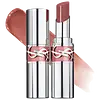What's inside
What's inside
 Key Ingredients
Key Ingredients

 Benefits
Benefits

 Concerns
Concerns

 Ingredients Side-by-side
Ingredients Side-by-side

Polybutene
Diisostearyl Malate
EmollientHydrogenated Polyisobutene
EmollientDiphenylsiloxy Phenyl Trimethicone
Skin ConditioningBis-Diglyceryl Polyacyladipate-2
EmollientOctyldodecyl Neopentanoate
EmollientHydrogenated Polydecene
EmollientDiisopropyl Dimer Dilinoleate
EmollientC10-30 Cholesterol/Lanosterol Esters
EmulsifyingOzokerite
Emulsion StabilisingPolyethylene
AbrasiveSynthetic Wax
AbrasiveSilica Silylate
EmollientMica
Cosmetic ColorantAloe Barbadensis Leaf Extract
EmollientSodium Hyaluronate
HumectantQuartz
AbrasiveBHT
AntioxidantButylene Glycol
HumectantCaprylyl Glycol
EmollientEthylhexyl Palmitate
EmollientHexylene Glycol
EmulsifyingPentaerythrityl Tetraethylhexanoate
EmollientSilica Dimethyl Silylate
EmollientParfum
MaskingPhenoxyethanol
PreservativePolybutene, Diisostearyl Malate, Hydrogenated Polyisobutene, Diphenylsiloxy Phenyl Trimethicone, Bis-Diglyceryl Polyacyladipate-2, Octyldodecyl Neopentanoate, Hydrogenated Polydecene, Diisopropyl Dimer Dilinoleate, C10-30 Cholesterol/Lanosterol Esters, Ozokerite, Polyethylene, Synthetic Wax, Silica Silylate, Mica, Aloe Barbadensis Leaf Extract, Sodium Hyaluronate, Quartz, BHT, Butylene Glycol, Caprylyl Glycol, Ethylhexyl Palmitate, Hexylene Glycol, Pentaerythrityl Tetraethylhexanoate, Silica Dimethyl Silylate, Parfum, Phenoxyethanol
Diisostearyl Malate
EmollientHydrogenated Polyisobutene
EmollientPhenyl Trimethicone
Skin ConditioningSynthetic Wax
AbrasiveC12-15 Alkyl Benzoate
AntimicrobialCetyl Dimethicone
EmollientOctyldodecanol
EmollientDiisopropyl Dimer Dilinoleate
EmollientPhytosteryl Macadamiate
Skin ConditioningPentaerythrityl Tetraethylhexanoate
EmollientEuphorbia Cerifera Cera Extract
Polyethylene
AbrasivePentaerythrityl Tetraisostearate
EmollientPolyglyceryl-2 Isostearate
EmulsifyingCI 77891
Cosmetic ColorantParaffin
PerfumingPassiflora Edulis Seed Oil
EmollientCera Microcristallina
Emulsion StabilisingHexadecene
SolventCI 77491
Cosmetic ColorantCI 77492
Cosmetic ColorantCI 77499
Cosmetic ColorantTocopheryl Acetate
AntioxidantCI 15850
Cosmetic ColorantPentaerythrityl Tetra-Di-T-Butyl Hydroxyhydrocinnamate
AntioxidantCaprylic/Capric Triglyceride
MaskingAluminum Hydroxide
EmollientSilica
AbrasiveTocopherol
AntioxidantFicus Carica Fruit Extract
HumectantParfum
MaskingDiisostearyl Malate, Hydrogenated Polyisobutene, Phenyl Trimethicone, Synthetic Wax, C12-15 Alkyl Benzoate, Cetyl Dimethicone, Octyldodecanol, Diisopropyl Dimer Dilinoleate, Phytosteryl Macadamiate, Pentaerythrityl Tetraethylhexanoate, Euphorbia Cerifera Cera Extract, Polyethylene, Pentaerythrityl Tetraisostearate, Polyglyceryl-2 Isostearate, CI 77891, Paraffin, Passiflora Edulis Seed Oil, Cera Microcristallina, Hexadecene, CI 77491, CI 77492, CI 77499, Tocopheryl Acetate, CI 15850, Pentaerythrityl Tetra-Di-T-Butyl Hydroxyhydrocinnamate, Caprylic/Capric Triglyceride, Aluminum Hydroxide, Silica, Tocopherol, Ficus Carica Fruit Extract, Parfum
Ingredients Explained
These ingredients are found in both products.
Ingredients higher up in an ingredient list are typically present in a larger amount.
Diisopropyl Dimer Dilinoleate comes from isopropyl alcohol and Dilinoleic Acid. It is used to soften and hydrate the skin.
This ingredient may not be fungal-acne safe.
Diisostearyl Malate is an emollient and most often used in lip products. It comes from isostearyl alcohol, a fatty acid, and malic acid, an AHA.
As an emollient, Diisostearyl Malate helps create a thin film on your skin to trap moisture in. This helps keep your skin soft and smooth.
Hydrogenated Polyisobutene is a synthetic polymer. Polymers are compounds with high molecular weight. Hydrogenated Polyisobutene is an emollient and texture enhancer.
In one study, Hydrogenated Polyisobutene showed better skin hydration levels than Caprylic/Capric Triglyceride. As an emollient, it helps keep your skin soft and hydrated by trapping moisture in.
Hydrogenated Polyisobutene is often used as a mineral oil replacement.
Learn more about Hydrogenated PolyisobuteneParfum is a catch-all term for an ingredient or more that is used to give a scent to products.
Also called "fragrance", this ingredient can be a blend of hundreds of chemicals or plant oils. This means every product with "fragrance" or "parfum" in the ingredients list is a different mixture.
For instance, Habanolide is a proprietary trade name for a specific aroma chemical. When used as a fragrance ingredient in cosmetics, most aroma chemicals fall under the broad labeling category of “FRAGRANCE” or “PARFUM” according to EU and US regulations.
The term 'parfum' or 'fragrance' is not regulated in many countries. In many cases, it is up to the brand to define this term.
For instance, many brands choose to label themselves as "fragrance-free" because they are not using synthetic fragrances. However, their products may still contain ingredients such as essential oils that are considered a fragrance by INCI standards.
One example is Calendula flower extract. Calendula is an essential oil that still imparts a scent or 'fragrance'.
Depending on the blend, the ingredients in the mixture can cause allergies and sensitivities on the skin. Some ingredients that are known EU allergens include linalool and citronellol.
Parfum can also be used to mask or cover an unpleasant scent.
The bottom line is: not all fragrances/parfum/ingredients are created equally. If you are worried about fragrances, we recommend taking a closer look at an ingredient. And of course, we always recommend speaking with a professional.
Learn more about ParfumPentaerythrityl Tetraethylhexanoate is an emollient that helps make your skin smooth and hydrated. It specializes in creating a non-oily and "wet" feeling on skin.
This ingredient comes from isostearic acid, a saturated fatty acid. It is a synthetic ingredient.
Polyethylene is a synthetic ingredient that helps the skin retain moisture. It is a polymer.
It is also typically used within product formulations to help bind solid ingredients together and thicken oil-based ingredients. When added to balms and emulsions, it helps increase the melting point temperature.
Synthetic Wax is created from fossil fuels such as natural gas. It is used to enhance texture, adjust pH, and as an occlusive.
It may also be used as an abrasive ingredient to exfoliate the skin.
Synthetic Wax may not be fungal acne safe.
Learn more about Synthetic Wax